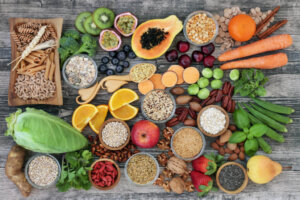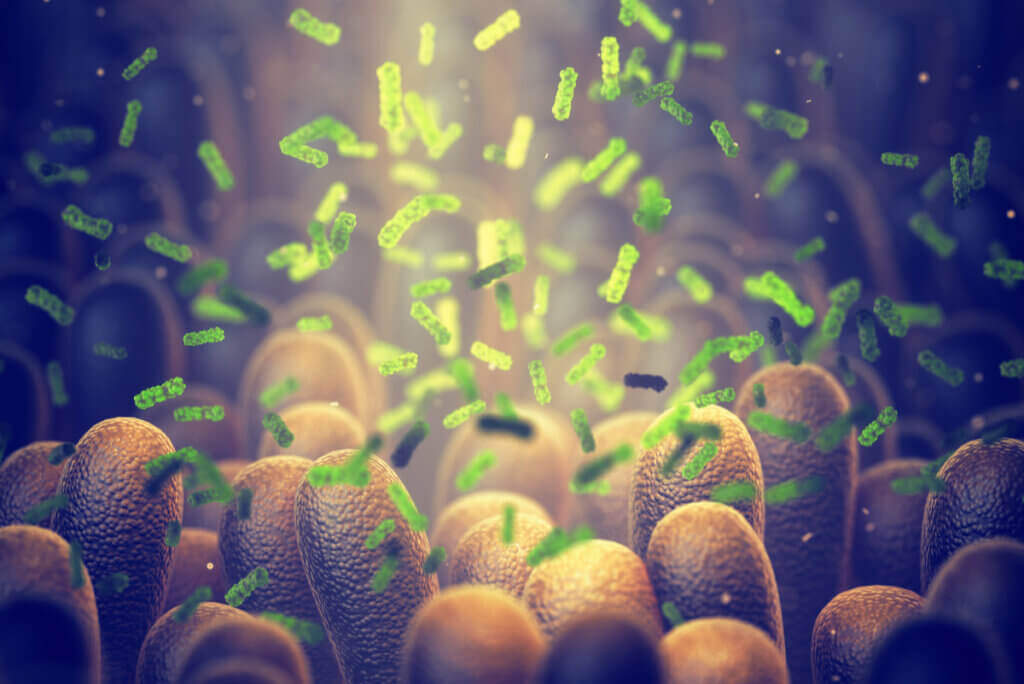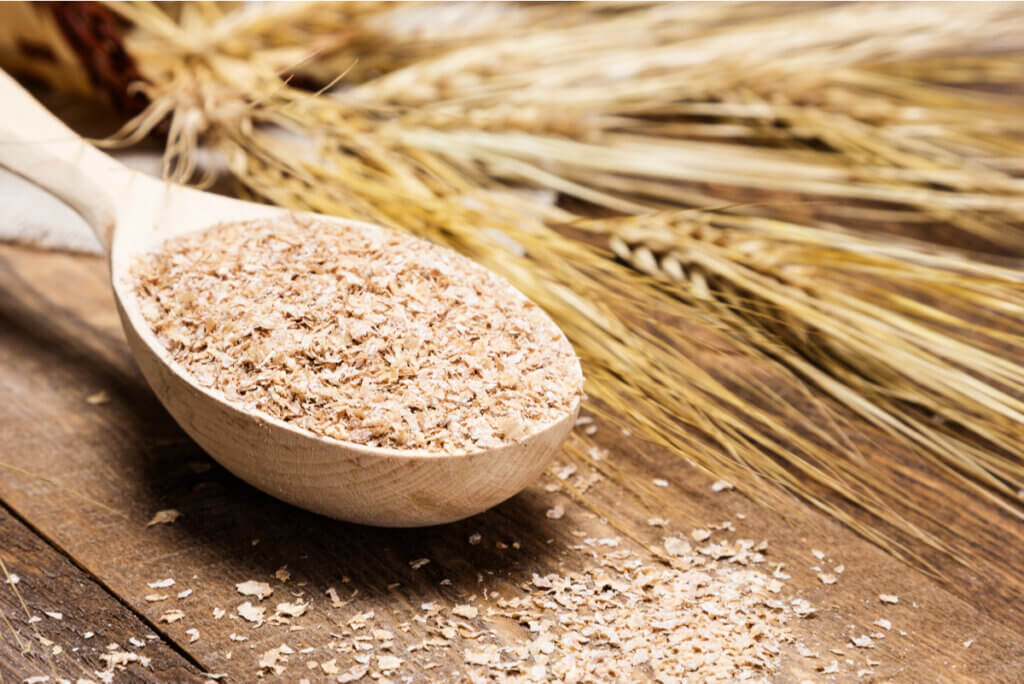What Is Dietary Fiber?


Escrito y verificado por el nutricionista Saúl Sánchez
Dietary fiber is a compound that’s present in many foods and is of great importance for health. Not only is it capable of reducing transit problems, but it can generate benefits in many of the systems that make up the body.
First of all, it should be noted that dietary fiber isn’t considered a nutrient. This substance doesn’t have nutritive power as such, but rather it exerts a fermentation from which usable by-products can be generated.
What is fiber?
Specifically, dietary fiber is an indigestible compound found in foods of plant origin that may have the ability to ferment in the intestines. It’s also capable of retaining water inside, increasing the volume of the fecal bolus. Therefore, it stimulates peristalsis and reduces the risk of constipation.
There are two types of fiber: Soluble and insoluble. The first one is characterized by trapping water molecules. It’s characteristic of foods such as oats and produces fermentation at the intestinal level. From this process, short-chain fatty acids with anti-inflammatory potential are generated. This is evidenced by a study published in the journal Gut Microbes.
On the other hand, insoluble fiber is present in grains such as whole wheat and only generates an increase in the volume of the fecal bolus without producing any type of fermentation. This stimulates the mechanoreceptors in the intestine, which increases the motility of the tube, improving transit. The association is confirmed in the Alimentary Pharmacology & Therapeutics journal.
Dietary fiber and the microbiota
One of the most important implications of fiber consumption has to do with its impact on the microbiota. Specifically, soluble fiber is capable of generating an effect on this organ, which is so important to the human body.
In fact, studies have managed to demonstrate that this compound serves as a nutrient for many of the bacteria that inhabit the intestine, thus allowing them to increase in number and carry out their functions.
At the same time, we mustn’t forget that in the processes of fermentation and formation of short-chain fatty acids, flora bacteria play an important role. Without them, this mechanism wouldn’t take place.
A good source of soluble fiber is oats. It has beta-glucans that are essential for the maintenance of healthy microbiota. At the same time, apples, with their pectin content, are capable of exerting such an effect.
Keep in mind that intestinal flora doesn’t only have implications at the digestive level. It modulates the substances and nutrients that pass into the bloodstream, which can condition the development of neurological diseases, such as Alzheimer’s. This seems to be promoted by the accumulation of amyloid beta that previously passed into the blood through the walls of a leaky gut.

Dietary fiber and intestinal diseases
In addition to impacting the health and biodiversity of the microbiota, dietary fiber can reduce the risk of developing various intestinal diseases. One of them is colon cancer. There’s evidence that the regular consumption of fiber cleanses the walls of the intestine and stimulates its function, which generates a protective effect on the formation of tumors.
Likewise, the soluble fiber that we talked about a moment ago has the ability to improve the management of many inflammatory diseases, such as irritable bowel syndrome. This is due to the formation of short-chain fatty acids, such as butyrate.
This series of compounds have proven to be useful in reducing the symptoms of this class of diseases that involve pain and increased markers associated with inflammation. In addition, they can cause intestinal disorders such as diarrhea or bleeding.
Supplementation with probiotics, together with fiber intake, is effective for the prevention and treatment of these problems. However, choosing the right product can be difficult if you don’t have the right knowledge.
Fiber intake and glucose absorption
Another of the main functions of dietary fiber is to modulate glucose absorption. This substance often acts as an antinutrient, reducing the availability of minerals such as calcium and iron.
With carbohydrates, it performs a similar function. It doesn’t block its absorption significantly, but it’s capable of slowing it down.
The main effect that this generates is a more gradual entry of glucose into the blood, which helps to avoid insulin spikes. In this way, the body’s cells are less likely to develop resistance to the hormone, which would lead to the appearance of type 2 diabetes.
In fact, the intake of fiber on a regular basis is proposed as a possible strategy for the management of this class of metabolic diseases. This is confirmed by research published in The Journal of Nutrition.
Foods Containing Dietary Fiber
Almost all foods from the plant kingdom have dietary fiber in their composition. As an exception, we can point out cereals and grains that have undergone refining processes. Their flours are also usually deficient in this substance.
When it comes to highlighting those that have a higher content of said substance, we can’t forget to mention oats. Also, the bran of several grains presents significant amounts.
As for fruits, the best options are always apples, pears, and kiwi. They contain pectins, a soluble fiber essential for the maintenance of a healthy microbiota.
When talking about vegetables, perhaps cruciferous vegetables are the most significant representatives. Both broccoli and cauliflower are capable of providing high doses of fiber, which improves the speed of intestinal transit.
An excess of dietary fiber can be negative
As in almost everything related to nutrition, an excess of dietary fiber can be harmful. Especially in those cases in which there’s dysbiosis, that is, alteration of the populations of bacteria that make up the microbiota. In these circumstances, harmful colonies of microorganisms are overdeveloped.
These situations require a complex nutritional intervention. Intestinal dysbiosis must be corrected, although it’s best to do so without resorting to the use of antibiotics. To do this, you have to significantly reduce your fiber intake for a certain period of time.
In this temporary space, offering a high-quality probiotic and then reintroducing fiber progressively is essential. In this way, a change in the configuration of the microbiota can be generated, which is beneficial for the functioning of the intestine.
Keep in mind that the most serious cases of dysbiosis occur with food intolerance, with a large production of gas and the genesis of subsequent pain, diarrhea, or constipation. For this reason, it’s essential to opt for a treatment to remedy the situation. However, a specialist must ensure the existence of the disease.

Problems with nutrient absorption
In addition to the case discussed, excessive consumption of fiber may be related to the appearance of nutritional deficiencies in terms of minerals. This occurs because this substance can act as an antinutrient.
The minerals that are most at risk of disrupting your metabolism if taken with a high amount of fiber are calcium, iron, and zinc. All three are important, so it’s key to ensure that their consumption generates adequate availability.
Dietary fiber: An essential substance
As discussed, dietary fiber is a substance that has many functions in the human body. In fact, a deficient intake is capable of generating health problems in the medium and long term. For this reason, the need to ensure that the requirements are met is worth highlighting.
As you’ve seen, there are two types of dietary fiber, each with specific functions. Both work well together and, in fact, can be found in different proportions in various foods. To ensure that the necessary amounts are consumed, including products of vegetable origin on a daily basis in the diet will suffice.
In any case, an excess of fiber can be counterproductive, especially if there’s dysbiosis. In these cases, it’s important to have the help of a professional to restore the balance in the microbiota, controlling the symptoms and allowing a return to a balanced and varied diet.
Dietary fiber is a compound that’s present in many foods and is of great importance for health. Not only is it capable of reducing transit problems, but it can generate benefits in many of the systems that make up the body.
First of all, it should be noted that dietary fiber isn’t considered a nutrient. This substance doesn’t have nutritive power as such, but rather it exerts a fermentation from which usable by-products can be generated.
What is fiber?
Specifically, dietary fiber is an indigestible compound found in foods of plant origin that may have the ability to ferment in the intestines. It’s also capable of retaining water inside, increasing the volume of the fecal bolus. Therefore, it stimulates peristalsis and reduces the risk of constipation.
There are two types of fiber: Soluble and insoluble. The first one is characterized by trapping water molecules. It’s characteristic of foods such as oats and produces fermentation at the intestinal level. From this process, short-chain fatty acids with anti-inflammatory potential are generated. This is evidenced by a study published in the journal Gut Microbes.
On the other hand, insoluble fiber is present in grains such as whole wheat and only generates an increase in the volume of the fecal bolus without producing any type of fermentation. This stimulates the mechanoreceptors in the intestine, which increases the motility of the tube, improving transit. The association is confirmed in the Alimentary Pharmacology & Therapeutics journal.
Dietary fiber and the microbiota
One of the most important implications of fiber consumption has to do with its impact on the microbiota. Specifically, soluble fiber is capable of generating an effect on this organ, which is so important to the human body.
In fact, studies have managed to demonstrate that this compound serves as a nutrient for many of the bacteria that inhabit the intestine, thus allowing them to increase in number and carry out their functions.
At the same time, we mustn’t forget that in the processes of fermentation and formation of short-chain fatty acids, flora bacteria play an important role. Without them, this mechanism wouldn’t take place.
A good source of soluble fiber is oats. It has beta-glucans that are essential for the maintenance of healthy microbiota. At the same time, apples, with their pectin content, are capable of exerting such an effect.
Keep in mind that intestinal flora doesn’t only have implications at the digestive level. It modulates the substances and nutrients that pass into the bloodstream, which can condition the development of neurological diseases, such as Alzheimer’s. This seems to be promoted by the accumulation of amyloid beta that previously passed into the blood through the walls of a leaky gut.

Dietary fiber and intestinal diseases
In addition to impacting the health and biodiversity of the microbiota, dietary fiber can reduce the risk of developing various intestinal diseases. One of them is colon cancer. There’s evidence that the regular consumption of fiber cleanses the walls of the intestine and stimulates its function, which generates a protective effect on the formation of tumors.
Likewise, the soluble fiber that we talked about a moment ago has the ability to improve the management of many inflammatory diseases, such as irritable bowel syndrome. This is due to the formation of short-chain fatty acids, such as butyrate.
This series of compounds have proven to be useful in reducing the symptoms of this class of diseases that involve pain and increased markers associated with inflammation. In addition, they can cause intestinal disorders such as diarrhea or bleeding.
Supplementation with probiotics, together with fiber intake, is effective for the prevention and treatment of these problems. However, choosing the right product can be difficult if you don’t have the right knowledge.
Fiber intake and glucose absorption
Another of the main functions of dietary fiber is to modulate glucose absorption. This substance often acts as an antinutrient, reducing the availability of minerals such as calcium and iron.
With carbohydrates, it performs a similar function. It doesn’t block its absorption significantly, but it’s capable of slowing it down.
The main effect that this generates is a more gradual entry of glucose into the blood, which helps to avoid insulin spikes. In this way, the body’s cells are less likely to develop resistance to the hormone, which would lead to the appearance of type 2 diabetes.
In fact, the intake of fiber on a regular basis is proposed as a possible strategy for the management of this class of metabolic diseases. This is confirmed by research published in The Journal of Nutrition.
Foods Containing Dietary Fiber
Almost all foods from the plant kingdom have dietary fiber in their composition. As an exception, we can point out cereals and grains that have undergone refining processes. Their flours are also usually deficient in this substance.
When it comes to highlighting those that have a higher content of said substance, we can’t forget to mention oats. Also, the bran of several grains presents significant amounts.
As for fruits, the best options are always apples, pears, and kiwi. They contain pectins, a soluble fiber essential for the maintenance of a healthy microbiota.
When talking about vegetables, perhaps cruciferous vegetables are the most significant representatives. Both broccoli and cauliflower are capable of providing high doses of fiber, which improves the speed of intestinal transit.
An excess of dietary fiber can be negative
As in almost everything related to nutrition, an excess of dietary fiber can be harmful. Especially in those cases in which there’s dysbiosis, that is, alteration of the populations of bacteria that make up the microbiota. In these circumstances, harmful colonies of microorganisms are overdeveloped.
These situations require a complex nutritional intervention. Intestinal dysbiosis must be corrected, although it’s best to do so without resorting to the use of antibiotics. To do this, you have to significantly reduce your fiber intake for a certain period of time.
In this temporary space, offering a high-quality probiotic and then reintroducing fiber progressively is essential. In this way, a change in the configuration of the microbiota can be generated, which is beneficial for the functioning of the intestine.
Keep in mind that the most serious cases of dysbiosis occur with food intolerance, with a large production of gas and the genesis of subsequent pain, diarrhea, or constipation. For this reason, it’s essential to opt for a treatment to remedy the situation. However, a specialist must ensure the existence of the disease.

Problems with nutrient absorption
In addition to the case discussed, excessive consumption of fiber may be related to the appearance of nutritional deficiencies in terms of minerals. This occurs because this substance can act as an antinutrient.
The minerals that are most at risk of disrupting your metabolism if taken with a high amount of fiber are calcium, iron, and zinc. All three are important, so it’s key to ensure that their consumption generates adequate availability.
Dietary fiber: An essential substance
As discussed, dietary fiber is a substance that has many functions in the human body. In fact, a deficient intake is capable of generating health problems in the medium and long term. For this reason, the need to ensure that the requirements are met is worth highlighting.
As you’ve seen, there are two types of dietary fiber, each with specific functions. Both work well together and, in fact, can be found in different proportions in various foods. To ensure that the necessary amounts are consumed, including products of vegetable origin on a daily basis in the diet will suffice.
In any case, an excess of fiber can be counterproductive, especially if there’s dysbiosis. In these cases, it’s important to have the help of a professional to restore the balance in the microbiota, controlling the symptoms and allowing a return to a balanced and varied diet.
- Morrison DJ., Preston T., Formation of short chain fatty acids by the gut microbiota and their impact on human metabolism. Gut Microbes, 2016. 7 (3): 189-200.
- Christodoulides S., Dimidi E., Fragkos KC., Farmer AD., et al., Systematic review with meta analysis: effect of fibre supplementation on chronic idiopathic constipation in adults. Aliment Pharmacol Ther, 2016. 44 (2): 103-16.
- Holscher HD., Dietary fiber and prebiotics and the gastrointestinal microbiota. Gut Microbes, 2017. 8 (2): 172-184.
- Gianfredi V., Salvatori T., Villarini M., Moretti M., et al., Is dietary fibre truly protective against colon cancer? A systematic review and meta analysis. Int J Food Sci Nutr, 2018. 69 (8): 904-915.
- Sun Q., Jia Q., Song L., Duan L., Alterations in fecal short chain fatty acids in patients with irritable bowel syndrome: a systematic review and meta analysis. Medicine, 2019. 98 (7): 14513.
- Weickert MO., Pfeiffer AFH., Impact of dietary fiber consumption on insulin resistance and the prevention of type 2 diabetes. J Nutr, 2018. 148 (1): 7-12.
Este texto se ofrece únicamente con propósitos informativos y no reemplaza la consulta con un profesional. Ante dudas, consulta a tu especialista.







